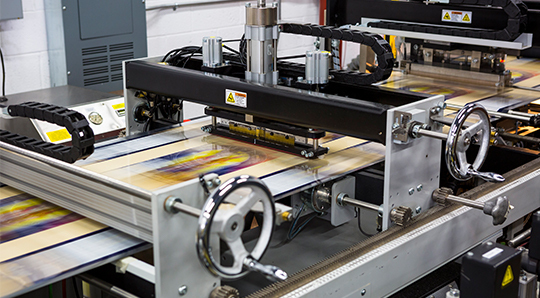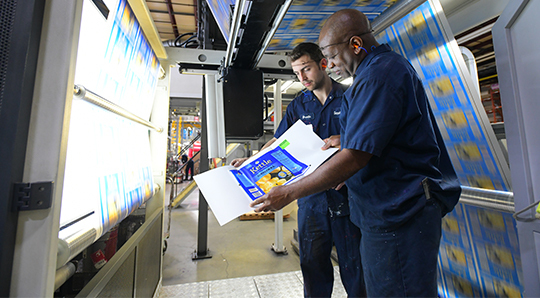In-house platemaking
Some converters make plates in-house. This eliminates the middleman, giving you quicker turnarounds and even greater control over your finished graphics.
On-site troubleshooting
Ask potential suppliers if they have on-call field service engineers. Their job is to understand the quality issue you’re observing, perform diagnostic tests to identify the root cause, and do whatever it takes to fix it.
There’s a laundry list of potential operational, performance, and print-quality issues you can experience with flexible packaging:
- Packaging that doesn’t meet the operational requirements of your packaging line(s)
- Packages with seals that leak
- Packages that are difficult to open
- Packages that don’t meet your shelf-life requirements
- Package graphics that don’t meet your standards and/or agreed upon color targets
Preventing these issues really comes down to your flexible packaging supplier’s experience.
They should be able to diagnose the root cause, remedy it, and help you prevent the same problem from reoccurring in the future. Easy enough to say; harder to do.

Diagnosing performance & operational issues
Recently, a brand approached us, saying they were experiencing quality issues when they ran our packaging material on their equipment.
So we dug deeper, asking questions like:
- What are you observing when you run your packaging lines?
- Are you meeting your throughput goals?
This uncovered that they were unable to adequately form seals on their equipment, so their finished flow-wrap packages were leaking.
We flew one of our field tech engineers to their plant to investigate the problem further. Once on-site, they observed the facility’s entire packaging line operations, paying special attention to the interaction of the material and equipment.
After a few diagnostic tests, our field tech engineer identified the root cause: The seal jaws were slightly out of alignment. Because the customer had backup seal jaws on-hand, our engineer was able to work with the customer’s maintenance group to install new seal jaws. This resolved the problem, and from that point on, the packaging material ran smoothly on the form/fill/seal line.
Even though the underlying issue was an equipment maintenance issue—not an issue with the quality of the flexible packaging material—we took responsibility for remedying it and preventing future problems. All of this occurred at no cost to the customer. It’s just a standard part of our inherent technical support and service.
It’s the same general process for all current and prospective customers: We seek to understand the quality issue you’re observing, perform diagnostic tests to identify the root cause, and do whatever it takes to fix it.
Questions to ask potential flexible packaging suppliers:
- Do you offer on-site technical support if packaging material isn’t running correctly on my equipment lines?
- What is the typical response time of your field technical service team?
- What steps and tools will your technical support team utilize to diagnose issues?
- Can you give me specific examples of times you assisted a brand in fixing packaging material performance or operational issues?
Fixing unacceptable print-quality issues
Your package’s graphics are the face of your brand in the marketplace. Rightfully so, brands have very particular expectations about the quality and consistency of colors, text, and imagery. The final package needs to reflect your design intent.
And flexible packaging suppliers with a full prepress department supporting their press rooms are best equipped to meet these expectations.
Flexible packaging printing presses are complex machines with strict tolerances. The prepress department should review your design to identify and address any potential issues, such as type that’s below tolerance, where spot colors will be required, specialized screening, etc. This pre-production stage should be collaborative, establishing agreed-upon expectations.
A flexible packaging supplier is also responsible for transforming your color preferences into numerical, measurable targets. This allows you to quantify printing quality.
Some converters even make plates in-house. This eliminates the middleman, giving you quicker turnarounds and even greater control over your finished graphics. If any package doesn’t meet your expectations, a good flexible packaging supplier should take single-source responsibility for addressing it.
Questions to ask potential flexible packaging suppliers:
- Can you do a quick review of my graphics to identify potential printing issues? What would you recommend modifying?
- What processes will you go through to ensure my packaging graphics are consistent, package after package and order after order?
- Do you have the equipment and expertise to make plates in-house?
- Can you share various examples of line and process printing from your press operations for our own print sample evaluation?
Let’s diagnose, remedy, and prevent your packaging quality issues
With six decades of experience manufacturing flexible packaging, we’ve encountered almost every packaging challenge. Let’s work together on yours — reach out today to start the conversation.
Let's talk flexible packaging.
Ask us your packaging questions, and we’ll see how we can help you overcome your next packaging challenge.

